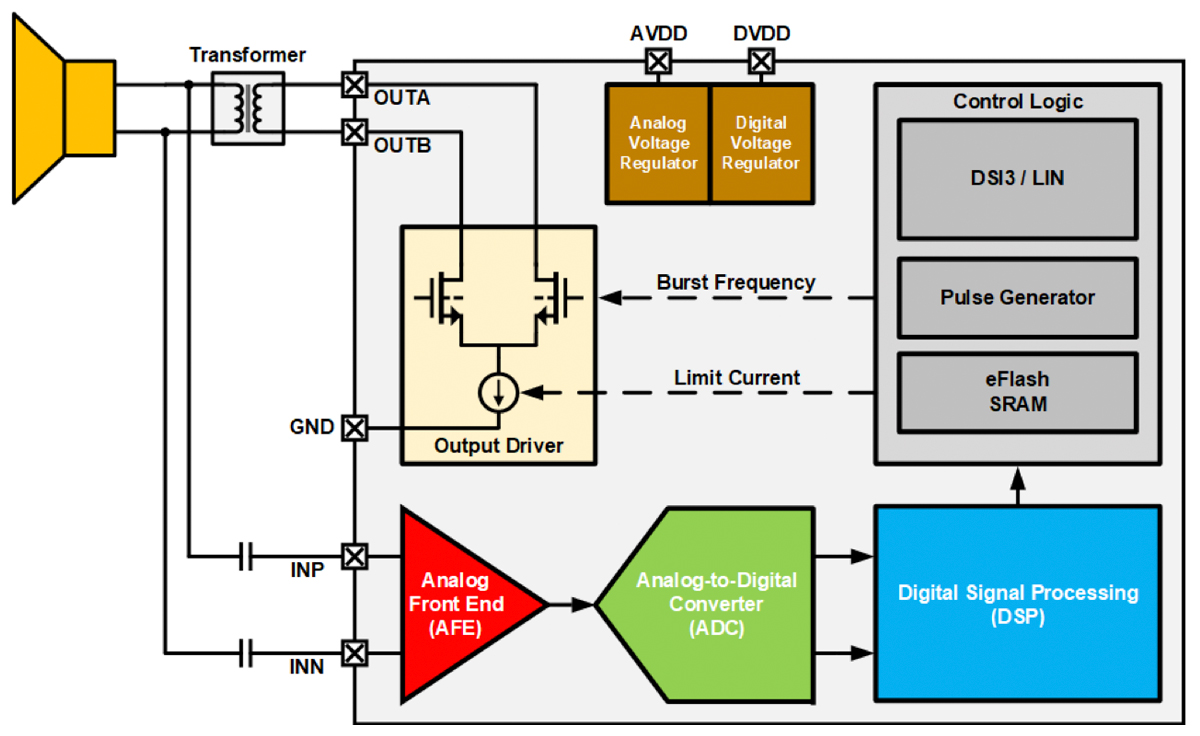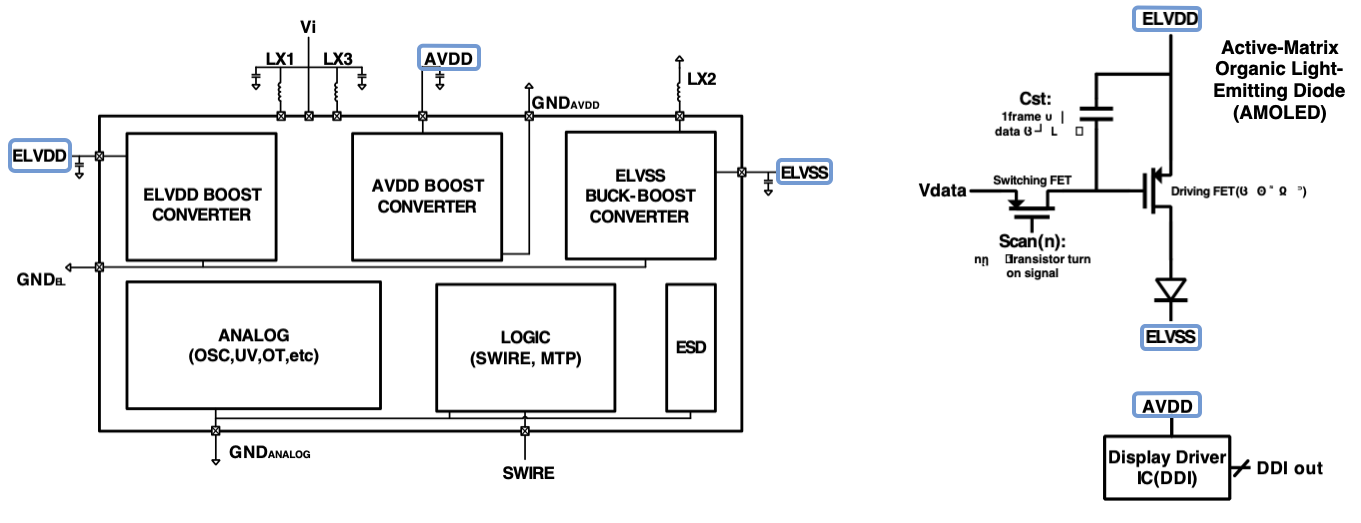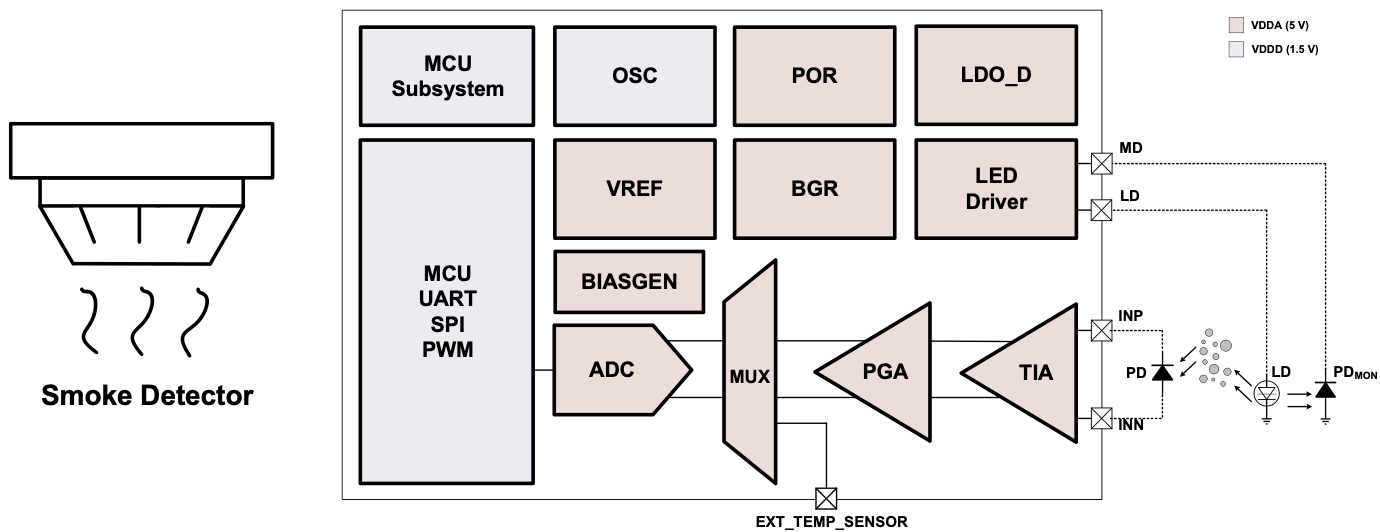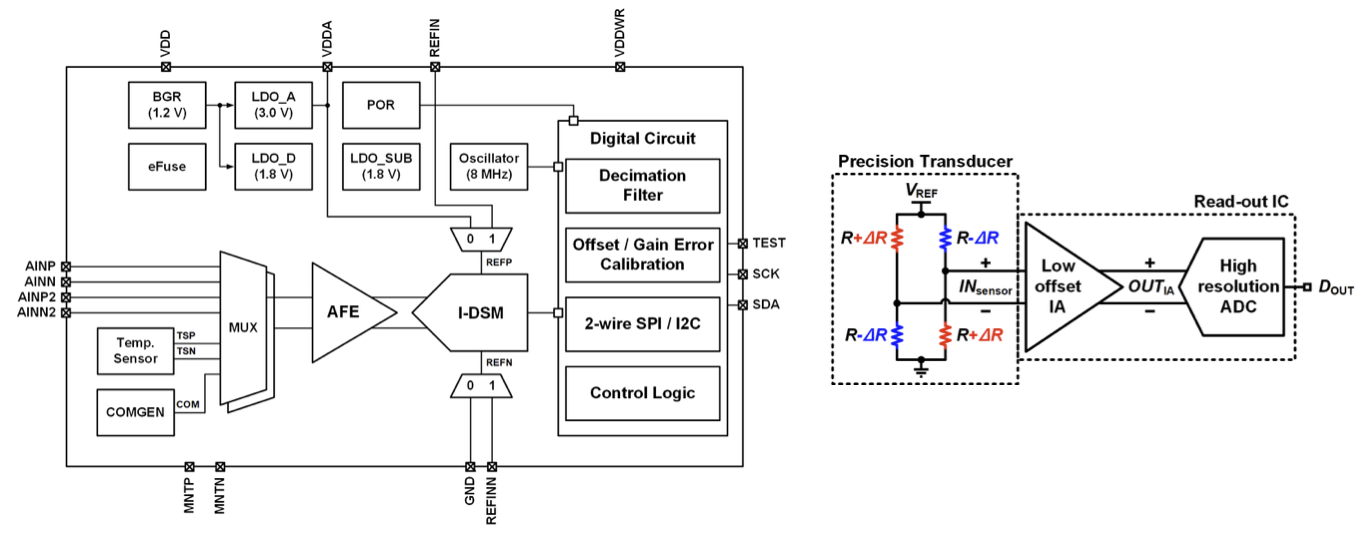Force Sensor Read-Out IC
Force sensor read-out IC (ROIC) is used to convert the force applied to the force sensor into a digital signal. Low noise and low power are required for the instrumentation amplifier (IA) and delta-sigma (∆∑) modulator in the ROIC to efficiently convert the signal of the corresponding sensor without loss.

Proximity Sensor Read-Out IC
Proximity sensor converts the distance from the sensor to a nearby object into a digital signal. The space between the target and the sensor makes a difference on input capacitance. The capacitance is measured and can be converted into a digital distance value with the sensor. Automatic calibration logic is required for higher sensitivity and to read a large DC capacitance value. This sensor requires a low noise, low power and high resolution Analog Front-End (AFE) for efficient readout. Proximity sensor can be applied to systems such as smartphones and car door handles, and so on.


Ultrasonic Sensor Read-Out System
The ultrasonic sensor read-out system receives and amplifies the echo reflected from an object, then converts the amplified signal into a digital signal and provides it to the digital signal processing block for distance measurement. The analog front end (AFE) provides a variable gain feature that can uniformly amplify the echo signal of objects at different distances without saturating the Analog-to-Digital Converter (ADC).


Airborne Particulate Matter Detector
The airborne particulate matter (PM) detector is for measuring the concentration of dust in the air. Light is irradiated from the inner laser diode (LD) driver module and scattered by particles in the air. The photodiode (PD) that senses the scattered light generates a current signal. The analog front-end (AFE) and analog-to-digital converter (ADC) convert the current signal to 12-bit digital signal. The microprocessor (MCU) distinguish the size and the concentration of PM from the digital signal by using machine learning algorithm.

Solar Energy Harvester
Solar Energy Harvester
The solar energy harvester extracts maximum power from the photovoltaic (PV) panel and delivers it to the load. The Maximum Power Point Tracking (MPPT) SoC senses the voltage and current of the PV panel and controls the DC-DC converter based on power computation, ensuring that the PV panel operates at its Maximum Power Point (MPP). By applying the DCR current sensing method, conduction losses are minimized, and the on-chip microcontroller unit (MCU) precisely controls the PWM signal, improving overall efficiency to establish an effective solar energy harvesting system. The solar energy harvester can contribute to a sustainable future by providing renewable energy for various applications such as residential units, electric vehicles (EVs), and agricultural operations.

Triple output AMOLED Display PMIC
Triple output AMOLED Display PMIC
The triple output AMOLED(Active-Matrix Organic Light-Emitting Diode) Display PMIC supplies stable voltages for AMOLED and DDI(Display Driver IC). There are 3 outputs in this PMIC chip, ELVDD for AMOLED supply voltage, ELVSS for AMOLED ground voltage, and AVDD for display driver IC supply voltage. This system integrates two boost converters for ELVDD voltage and AVDD voltage, and an inverting buck-boost converter for ELVSS voltage. The digital interface control pin (SWIRE) allows programming ELVDD voltage, ELVSS voltage and AVDD voltage in digital steps.

Smoke Detector
Smoke Detector
A smoke detector system is an electronic device designed to detect the presence of smoke by using optical sensing and signal processing techniques. It incorporates several components including an oscillator (OSC), power-on reset (POR), low-dropout regulator (LDO), bandgap reference (BGR), LED driver, transimpedance amplifier (TIA), programmable gain amplifier (PGA), multiplexer (MUX), analog-to-digital converter (ADC), and a microcontroller (MCU). The detection process begins with the LED driver emitting light into the smoke chamber, where a photodiode detects light scattered by smoke particles. The photodiode generates a small current proportional to the intensity of scattered light, which is then converted to a voltage by the TIA. This voltage signal is passed to the PGA for adjustable amplification, ensuring the signal strength is optimized for conversion. The MUX selects the appropriate signal channel if multiple inputs are used, and the ADC converts the amplified analog signal into a digital format. The digital data from the ADC is processed by the MCU, which evaluates the smoke concentration based on predefined thresholds. If the smoke level exceeds a certain limit, the MCU triggers an alarm. This comprehensive design allows for accurate and efficient smoke detection, with high reliability and low power consumption, making it suitable for continuous monitoring in safety-critical applications.

Temperature-to-Digital Converter
Temperature-to-Digital Converter
In precision measurement systems and sensors, accurate knowledge of the die temperature is critical, as it helps reduce temperature-induced cross-sensitivity. In these systems, the inaccuracy of Temperature-to-Digital Converters (TDCs) is a key contributor to the overall error budget, often limiting system performance. The system architecture includes a frontend that generates VBE and ΔVBE signals, which are subsequently processed by an incremental ADC. The ADC utilizes a second-order CIFB structure to ensure high resolution, enabling precise digital calibration and trimming.


DC Measurement System
DC Measurement System
This system is a precision 24-bit analog-to-digital converter (ADC). It includes an on-chip low-noise amplifier, an on-chip oscillator, and a precision second-order 24-bit delta-sigma (ΔΣ) modulator, providing a complete front-end solution for bridge sensor applications such as weigh scales, strain gauges, and load cells. The low-noise amplifier has a gain range of 1 to 128, supporting a full-scale differential input of ±2.8V. The ΔΣ ADC features a 24-bit resolution and consists of a second-order incremental delta-sigma modulator and a third-order sinc filter. Four data rates are supported: 10 SPS, 40 SPS, 500 SPS, and 1000 SPS.

